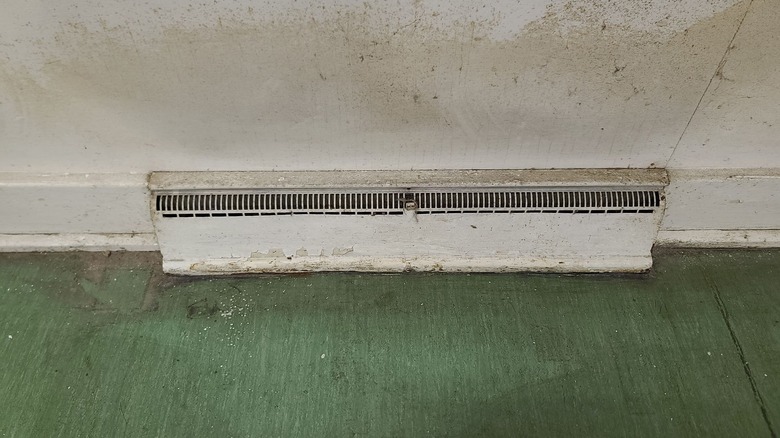The Deadly Reason You Might Not Want To Cover Your Electric Baseboard Heaters
As a national trend, unusually cold winters have become less common in the United States since the 1980s, but thousands of families still spend huge chunks of the year hiding away from blistering blizzards in homes kept warm by insulation. For many Americans, who don't have the itch to go snowboarding and don't have a woodstove to burn pine in, their idea of a nice winter day involves a cup of hot cocoa, a good book, and cranking up their electric baseboard heaters to full blast.
There are things to love about baseboard heaters. They tend to operate quietly via convection heating, thus they don't kick up any dust, and they don't take up a ton of space. They're also far cheaper to install than other heating options. However, they're also known as a culprit of awfully high energy bills, and perhaps even worse, these zonal heaters are an eyesore — intruding upon every room and breaking up a home's baseboard with aluminum fins. It's no wonder that many people are interested in buying covers for them, so they're a bit less ugly to look at.
However, before you go buying a product like the NeatHeat 4ft baseboard heater cover, you'll need to read the fine print — and know which type of baseboard heater you have. Most of these heaters are specifically designed for a hydronic baseboard heating system, which operates via a furnace and tends to reach lower temperatures overall. If you have an electric baseboard heater installed, on the other hand? Covers are harder to come by, and the reason why comes down to safety.
Putting the wrong cover on an electric baseboard heater is a fire risk
Electric baseboard heaters run much hotter than hydronic ones, so it's easier for the vents to overheat and ignite nearby items. That means these heaters become less efficient if the hot air they facilitate is trapped behind an object, and they pose a potentially fatal danger if obstructed.
It's worth noting that there are a limited number of electric baseboard heater covers sold, but even these products specify that they are rare, and they are often poorly reviewed or very expensive. So it is possible to cover electric baseboards, but trickier, requires a lot more research, and means spending a lot more. Casually placing covers over a vent without having an electrician verify the safety can be hugely risky, as covers make it more likely that your system will overheat nearby flammable materials like window curtains (something that generally isn't a concern if the electric baseboards are left otherwise unobstructed). You also want to make sure your filters are being cleaned or replaced on a regular basis, as detritus from the surrounding room can easily block up your vents. This isn't just a hypothetical concern; there are many reports of fatal fires sparked by electric baseboard heaters across the country. Do note that hydronic baseboard heaters do not have these same problems, hence why most covers are made for hydronic units.
Heating your home can contribute upwards of 29% of your utility bill, according to the U.S. Department of Energy, so it's worth keeping these potential dangers in mind if you're looking to upgrade your home's heating system anytime soon.

